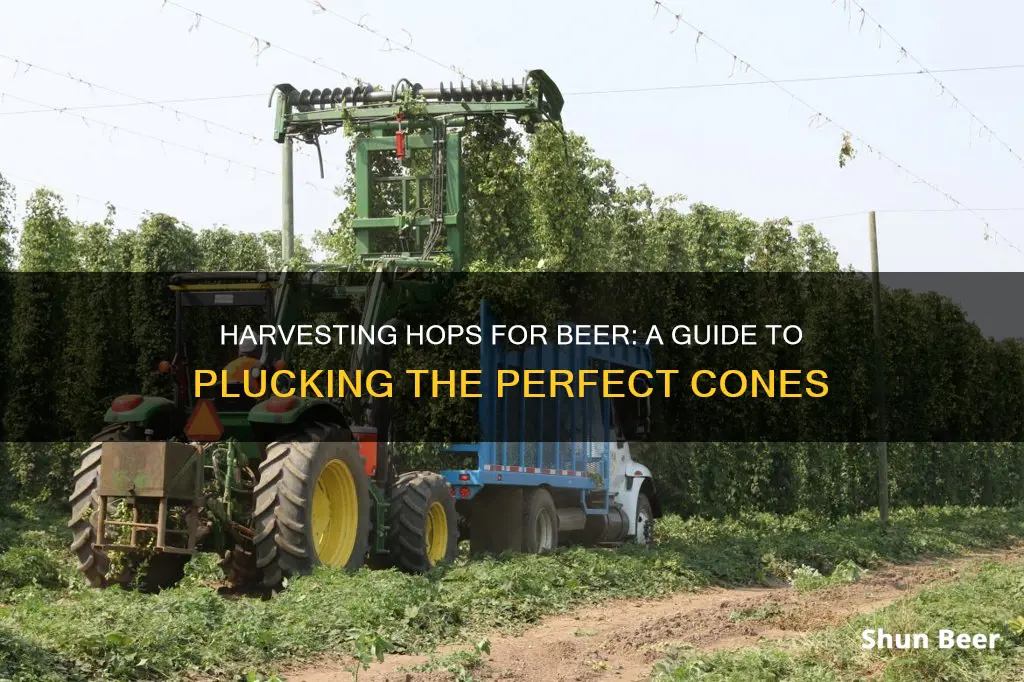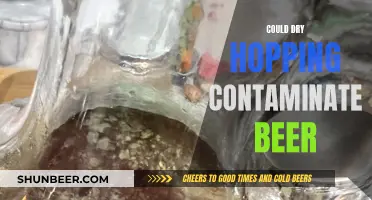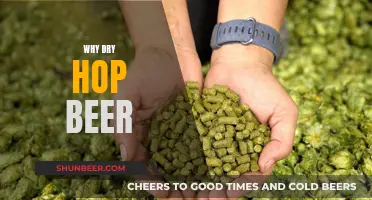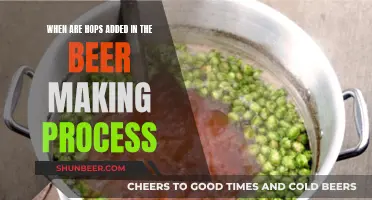
Hops are the female flower cones of the hops plant, a long, climbing vine. They are one of the main ingredients in beer, added during the brewing process to preserve the beer and give it its classic bitter flavor. Harvesting hops is easy and rewarding, but it's important to know when and how to do it. The harvest date varies with variety, weather, and location, but in most places, it occurs between mid-August and September. To check if your hops are ready to harvest, gently squeeze the cone. If it stays compressed, it's not ripe enough. When they feel light, dry, and spring back after a squeeze, they're ready. You can also smell the cone—if it has a pungent smell between cut grass and onion, it's time to harvest. There are two methods for picking your hops: by hand, or by cutting down the bine. After picking, the hops must be dried and stored properly to prevent rot.
| Characteristics | Values |
|---|---|
| When to harvest hops | Between mid-August and September, depending on location and the weather. In some cases, it can be as early as July. |
| How to check if the hops are ready | Squeeze the cone gently – if it stays compressed, it's not ready. If it feels light, dry and springy, it's ready. If it's sticky, that's another sign of readiness. |
| How to harvest hops | Pick the hops off the bine by hand (recommended for first-year harvests). Cut the bine down (recommended for all harvests after the first year). |
| What to wear when harvesting hops | Durable, abrasive-resistant clothing, gloves and goggles. |
| How to dry hops | Air drying, oven drying, hop drying screen, food dehydrator. |
| How to store hops | Weigh out and separate into one- or two-ounce bags. Place in plastic freezer bags, food saver bags or airtight jars. Push as much air out of the containers as possible and store in the freezer. |
What You'll Learn
- When to harvest hops: when they're dry and aromatic, usually between August and September?
- How to know if hops are ready to harvest: squeeze the cone – if it feels light and springy, it's ready?
- How to harvest hops: there are two ways – pick the hops off the bine, or remove the bine from the trellis and pick later?
- How to dry hops: air drying, using a food dehydrator, or in the oven?
- How to store hops: remove oxygen, seal, and store in a cold, dark place?

When to harvest hops: when they're dry and aromatic, usually between August and September
Knowing when to harvest hops is a tricky business. Unlike most things we grow in the garden, hop cones are the plant's flowers, so they don't ripen like fruit and vegetables. The good stuff for beer (the powdery yellow 'lupulin') is hidden beneath the petals. Thankfully, there is a relatively long window for hop picking if you're growing for home consumption. As with most harvests, the flowers develop at different rates on the same plant, so when some are beginning to fade, and others are just coming up to readiness, most of the flowers in between will be at their best.
Most hops in the Northern Hemisphere are ready to harvest between mid-August and the end of September. In the UK, this window falls towards the end of August and through September.
The most accurate way to test for ripeness is to test the cones' dryness. Most hop varieties are ready to harvest when they have reached about 23% dry matter. To test this, take a sample of your hops on a day when it hasn't rained for a couple of days and harvest the sample after the dew has cleared. Dry the sample out completely using a food dehydrator, a conventional oven, or a microwave (although this is not recommended as the sample may be too small to absorb all of the wave output and can damage the microwave). Weigh the sample often. Once the weight levels out and hasn't changed for two to three weigh-ins, they are dry.
You can also look out for certain characteristics in your hops. These include:
- The cone starting to fan out and bulge
- The edges of the cone starting to dry out and brown
- The presence of lupulin (a pollen-like substance) when you bend or break a cone
- The cones feeling dry and papery, and springing back to their original shape after being compressed
- The expected hop fragrance—a mix of pungent, pine, onion, and grass
If they smell vegetal or "green", they are not ready.
If you want to be sure you're harvesting at the optimal time, the dry matter calculation is the best method. But if your hops adhere to the above characteristics, you can be reasonably sure they are ready to harvest.
Hops in Beer: Necessary or Overrated?
You may want to see also

How to know if hops are ready to harvest: squeeze the cone – if it feels light and springy, it's ready
Hops are the female flower cones of the hops plant, a long, climbing vine. They are one of the main ingredients in beer, added during the brewing process to preserve the beer and give it its classic bitter flavour.
Hops harvesting doesn't take place as soon as the flowers appear. Hops harvest season is when the cones have had some time to dry out on the vine, usually from mid-August to September.
To figure out when to harvest hops, squeeze the cone gently with your fingers. You want it to feel light and springy, with a sticky sap coming out of it. If the cone stays compressed after you squeeze it, it's not ripe enough. If it feels damp and squishy, it's not ready. When they feel light and dry, and spring back after a squeeze, they're ready to be harvested.
The cones will also have a pungent smell, somewhere between cut grass and onion, when they are ready to harvest.
Hops and Cannabis: THC in Beer Explored
You may want to see also

How to harvest hops: there are two ways – pick the hops off the bine, or remove the bine from the trellis and pick later
Harvesting hops is easy and rewarding. There are two ways to go about it: pick the hops off the bine or remove the bine from the trellis and pick later.
If you choose to pick the hops off the bine, it is recommended that you wear gloves and long sleeves as hops bines are abrasive and can cause skin irritation. This method is best if not all the cones have reached maturity, as it allows you to grab the best cones and leave the others to mature. Picking the hops directly off the bine also has the added benefit of leaving the bine behind, allowing nutrients to be reabsorbed into the roots.
The second method involves removing the bine from the trellis and cutting it down. Cut the bine about three feet from the ground and pull the severed vine off its trellis. This method is preferred by hop farms as it allows for a quicker harvest and drying to begin before spoilage can occur. After cutting the bines, hang the whole bine up to dry.
Regardless of the harvesting method chosen, it is important to dry the hops properly to prevent spoilage. Drying methods include using a food dehydrator, oven, or window screen. When the hops are dry, they should be stored in airtight containers or bags with as much air removed as possible.
Growing Beer Hops Indoors: A Step-by-Step Guide
You may want to see also

How to dry hops: air drying, using a food dehydrator, or in the oven
Drying hops is an essential step in the process of dry hopping, which is a great way to introduce a fresh hops aroma to your beer. There are several ways to dry hops, including air drying, using a food dehydrator, or an oven.
Air Drying
Air drying is the most traditional method of drying hops. Simply cut the hops from their bines and tie them into bundles. Hang these bundles upside down in a warm, dry, well-ventilated area. Leave them for several days or until the hops are completely dry. This method can take several days or even weeks, depending on the humidity and temperature of your location.
Using a Food Dehydrator
If you have access to a food dehydrator, this can be a quicker and more efficient way to dry your hops. Simply place the hops on the trays of the dehydrator and set it to a low temperature (around 100-125°F). Check the hops regularly and remove them from the dehydrator once they are completely dry. This method can take several hours or a few days, depending on the humidity and temperature of your location.
Using an Oven
If you don't have a food dehydrator, you can also dry hops in your oven. Preheat your oven to the lowest temperature setting (around 170-200°F). Spread the hops out on a baking tray in a single layer and place them in the oven. Leave the oven door slightly ajar to allow moisture to escape. Check the hops regularly and remove them from the oven once they are completely dry. This method can take several hours or a full day, depending on the humidity and temperature of your location.
Once your hops are dried, you can package and store them until you are ready to use them for dry hopping. Remember to use fresh and high-quality hops for the best results in your beer.
Crafting the Perfect Rolling Hop Beer: A Brewer's Guide
You may want to see also

How to store hops: remove oxygen, seal, and store in a cold, dark place
To store hops, you'll need to remove oxygen, seal the container, and store the hops in a cold, dark place.
Oxygen is the enemy of your hops, so limiting their exposure to oxygen is critical for long-term storage. Vacuum sealers are a great way to remove oxygen from the container. If you don't have a vacuum sealer, you can manually push out as much air as possible from the bag before sealing it.
Once your hops are sealed, store them in a cold, dark place. The colder the storage temperature, the longer your hops will last in terms of aroma, flavour, and alpha acid preservation. A chest freezer is ideal, but the freezer in your kitchen fridge also works. If you're using the kitchen freezer, surround your hops with frozen water bottles or ice packs to stabilise the temperature. Keep your sealed hops in a trash bag or other opaque container to protect them from light.
Hemp and Hops: Exploring the Botanical Cousins
You may want to see also
Frequently asked questions
Hops are usually ready to harvest between late August and September, depending on your location. You can test if a cone is ready by gently squeezing it. If it feels light, dry, and springy, it's ready. If it feels damp and squishy, it's not.
There are two methods: picking the cones by hand or cutting down the vine. Hand-picking is recommended for first-year harvests, while cutting the vine is suitable for subsequent years. Wear protective clothing, such as long sleeves, gloves, and goggles, as hops can cause skin irritation.
You need to dry the hops to prevent rot and preserve their quality. Air drying is a common method, using a window screen, oven, or food dehydrator. Ensure the hops are completely dry before storing them.
Place your dried hops in an airtight container, such as a vacuum-sealed bag or jar, removing as much air as possible. Store the hops in a freezer until you're ready to use them in your beer-making process.
Fresh hops contain about 80% water, so you'll need more than you would with dry hops. Use fresh hops at a rate of four to six times the amount of dry hops. For example, use four to six ounces of fresh hops for one ounce of dry hops.







